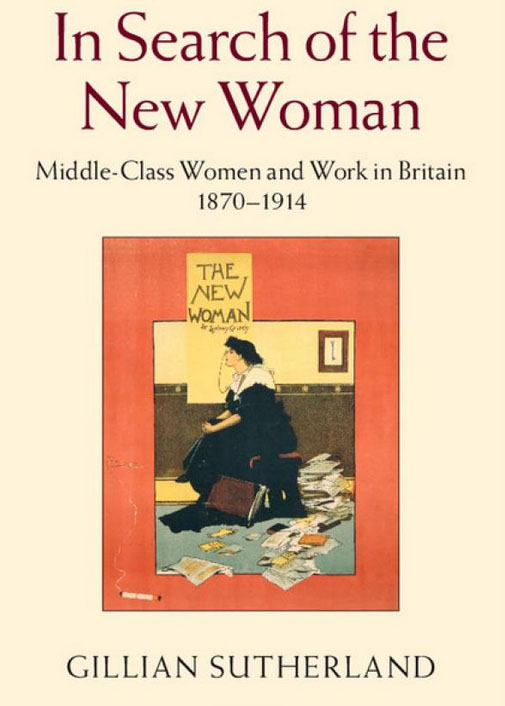In Search of the New Woman
Book Review

In Search of the New Woman: Middle-Class Women and Work in Britain 1870-1914 by Gillian Sutherland
(Cambridge University Press), 2015
187pp., £55 hard, ISBN 978-1-107-09279-2
Women increasingly demanded and gained constructive and useful roles in society with campaigns for control over property, economic independence and admission to education and to the professions. The suffrage movement, educational reform, the campaign against the Contagious Diseases Acts and the fight to distribute birth control information all contributed to the assault of male dominated social and political control. Social attitudes were also beginning to change: in the 1880s and 1890s, W. S. Gilbert was far softer in his satire of middle-aged spinsters than his predecessors in the music halls and in popular literature, independent women became heroines for the first time. But this was a slow process. Female networking became an important feature in the lives of unmarried women in the late-nineteenth and early-twentieth centuries. The 1891 and 1901 Censuses showed that many women lived alone, often in blocks of mansion flats occupied by other unmarried women. In a society that had yet to find a solution to the question of what to do with single women and where employment opportunities were still severely restricted, sharing accommodation made economic sense.
The literary expression of the assault on established social constructions of gender in the 1880s and 1890s was the ‘New Woman', an ambiguous and ill-defined expression of the contradictions of the fin de siècle, at once too sexual and not sexual enough, desiring a single emancipated lifestyle yet advocating eugenic procreation that feminists eagerly appropriated to affirm their modernity. Although ‘New Women' did not necessarily agree in their writings and through their representations in novels, they did address a number of contentious issues, including the marriage question, maternity and education for women. Between 1883 and 1900, over a hundred novels were written about the ‘New Woman'. Numerous female authors, including Olive Schreiner, Sarah Grand and Mona Caird become synonymous with the ‘New Woman' novel that was produced amid great controversy and soon disappeared largely because its didactic and frank examination of issues such as education and marriage was increasingly accepted. The shock experienced from her ‘outrageous' opinions at the beginning of the 1890s was no longer needed as the century drew to an end. In reality, there were few ‘new women' and the label can be most convincingly applied to the young middle-class woman who not only had a job but maintained herself and lived on her own or with another young woman, in an apartment. This entailed a complete departure from the domestic obligations traditionally filled by this age group. Yet whether the ‘New Woman' actually existed beyond the hostility of the anti-feminist press or, as some have suggested, at the cusp of fiction and fact is debatable. It is perhaps best to view the ‘New Woman' as a radical cultural icon representing the multiple political and social goals of largely middle-class women.
The fact that women could now live independently of men seems to have inspired new concerns and became the focus of a great deal of anxious and acerbic polemic. The New Woman was lampooned and shown in a variety of unladylike postures such as playing golf and riding bicycles. The pages of Punch, a journal renowned for its anti-feminism, provide historians with the popular caricature of the New Woman as the ‘Revolting Daughters', the ‘Shrieking Sisterhood' and the ‘Wild Woman'. Her aspirations to education and entry into the professions were derided in its pages throughout the 1890s. On the women's campaign for the vote, Punch was equally biting: Suffragettes were uniformly old, ugly, butch and bespectacled. The ‘New Women' of late nineteenth-century Britain were seen as defying conventions. Studying this phenomenon from its origins in the 1870s to the outbreak of the Great War, Gillian Sutherland examines whether women really had the economic freedom to challenge social norms relating to work, political action, love and marriage.
The reality, as Gillian Sutherland demonstrates, is that the critical female agents of change were not the much-discussed, much-caricatured ‘New Woman' but clerks and especially schoolteachers. 'The ‘new woman' was typist, nurse, schoolteacher or actress - beneficiaries of educational reform in 1870 and especially 1902 and the assault on higher education, and who advocated social reform, economic independence and political liberty. It was these women who were the vanguard for change in class and sexual relations and national culture in Britain in the early-twentieth century. Theirs was not the flamboyant aestheticism of female novelists but a process of gradual infiltration into the bastions of masculinity. This can be seen, for instance, in their replacement of men as clerks in both the private and, even more gradually, the public sectors from the 1880s. Poorly paid, discriminated against and with little job security should they consider marriage, this represents the beginnings of a process-still woefully incomplete-of women demanding an equal place in the workforce to men and equality of opportunities in employment. This is an important book in understanding the as yet incomplete journey of women into the work of work.

